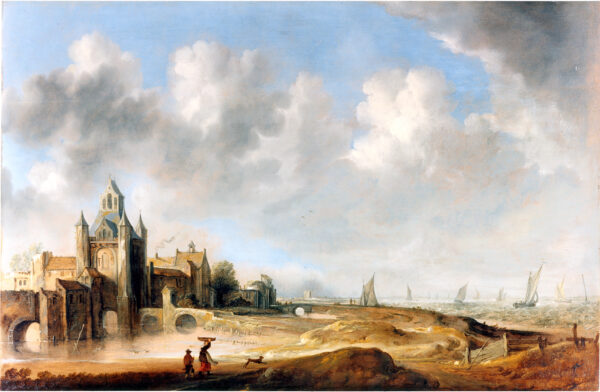“Dutch coastal town along the Zuiderzee”
Oil on panel: 68,5 x 103 cm;
signed and dated ‘A. v. Neer 1641’ (lower right on a post)
"*" indicates required fields
Notes
Previously this work was titled ‘Elburg’. Recent research has shown that this location is not viable. (Laurens Schoemaker, RKD, 2013).
Stechow notes that this maginificent work by Art van der Neer marks an important change in Dutch landscape painting and in Van der Neer’s Oeuvre (p.92). It opens ‘a decisive chapter in the history of colour (…) as van der Neer, whose earliest works are still a complete mystery to us, left behind the realm of grey-brown(-green) tonality, to which he had adhered through the late thirties ( …) down to about 1641 (fig 205), and began to concentrate on problems of a new luminosity’. After this work, he found his ideal subjects not only in landscapes illuminated by the setting, sun, the moon or flames but also in winter scenes with snow.
As in works by Jan van Goyen and Salomon van Ruisdael, the present painting also allows the sky to occupy a large part of the painting, which was very unusual for Van der Neer. Stechow mentions that this painting is unusual also for the early 1640s because of the restless see, dramatic clouds and buildings of a more imaginary type, and the whole mood quite different from the rather placid one of Van Goyen and his followers: ‘Jacob van Ruisdael does not seem too far away’ (Stechow pp.103-4). Apparently, the artist was experimenting on a combination of different and natural elements in this specific painting.
The staffage is doubtlessly authentic, as thorough technical research has pointed out. The extra staffage mentioned by Hofstede de Groot and visible in old illustrations, only consisted of some cows. They were removed in the early 1960’s when assumed to be later.
Identification of the city as Elburg is not viable; compare also the drawing by Adam Frans van der Meulen in Paris, Gobelin National 95, Armoire 78. Cf. the copy in sale Amsterdam, Paul Brandt, 18 May 1971, lot 22 (‘S. de Vlieger of omgeving’ with the later added staffage and also with the additional horseman in the foreground of the present painting) (W. Schulz, op. cit).
Provenance
- sale Jan Maul, Leiden Sept. 1782, lot 66;
- to art dealer L.B. Cocklers, Amsterdam, Leiden, 1782;
- Bury; art dealer Pieter de Boer, Amsterdam, Summer 1937 catalogue no. 23 (as ‘1644’);
- collection Geoffrey H. Berners, Esq. Woolverstone Hall, Suffolk;
- with art dealer Frank Sabin, London;
- private collection Stockholm;
- Art dealer Houthakker, Amsterdam;
- with art dealer Pieter de Boer, Amsterdam, 1950, in catalogue June 1954, with ill.;
- with art dealer Fischer, Luzern, exhibition catalogue March 1956, with ill.;
- with art dealer F. Enneking, Amsterdam, exhibited in Delft in 1961;
- to a private collection, Stockholm;
- sale London, Christie’s July 1965;
- Zürich, Koller November 1976;
- sale London, Sotheby’s, December 1988;
- Art dealer Joseph Guttmann, Los Angeles 1991, in cat. 1992, no. 12, with colour ill. in reverse;
- sale New York, Christie’s, January 1998;
- to Pieter de Boer, Amsterdam;
- to an important private collection in the Netherlands in 1999;
Literature
- Hofstede de Groot, ‘A Cat. Raisonné of the works of the most eminent Dutch Painters of the 17th Century’,no.14, p. 366;
- Illustrated London News. 10 December 1938;
- handbook of the Delft Antiekbeurs, 1961, ill.;
- Stechow, ‘Dutch Landscape Painting of the 17th century’, National Gallery of Art, London 1966, pp. 92, 104 & note 16 on 206, with ill. no 205;
- Bachmann, ‘Aert van der Neer’, 1982, p. 37, with ill. no. 12.
- ill. handbook Amsterdam, PAN 1998, colour ill. p. 82;
- Schultz, ‘Aert van der Neer’, Doornspijk, 2002, no. 1230, with colour plate no. 33 and ill. no. 93.

